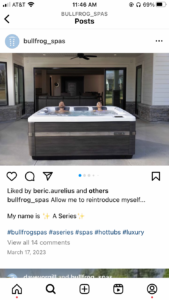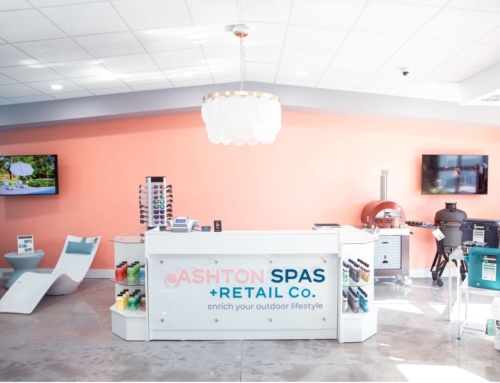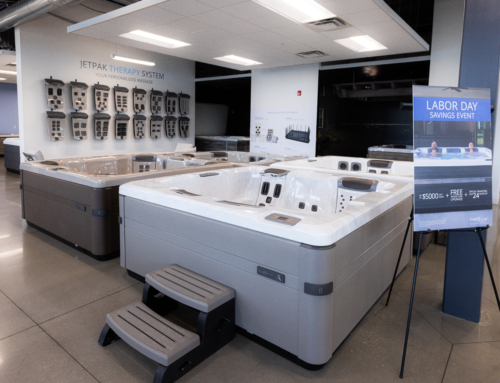A well-defined brand helps differentiate a business from competitors and creates a unique identity that resonates with customers. Consumers tend to buy from brands that resonate with them as these brands often align with their values, beliefs, and lifestyle preferences. By developing a brand that communicates your values, quality, and customer service, you can attract attention and build trust with potential buyers, making your business a preferred choice. By investing in brand building, businesses can create a sustainable competitive advantage that drives growth and profitability over the long term.
Building a reputable brand is especially essential for hot tub dealers trying to carve out their own space within the market. Differentiating your brand is essential in a crowded marketplace, where customers have numerous options. A strong brand fosters customer loyalty, which is invaluable for long-term success. Additionally, as a dealership’s brand gains recognition and trust, they can command higher prices for spas, reflecting the perceived value and quality associated with the brand and ultimately increasing the dealership’s revenue.
What goes into building a brand?
Creating a strong brand involves a multi-faceted approach that revolves around several core elements, all working together to establish a cohesive identity. At the heart of a brand are the company’s mission, values, voice, vision, customer persona, culture, and more. These components form the foundation of what the brand represents and how it is perceived by both employees and customers.

To effectively build a brand, it’s essential to focus on the message you want to send to your customers and how you want them to perceive your business. Bullfrog Spas’ Creative Director, Bret Ivory, who has been working with top lifestyle brands for over 25 years, had some advice for businesses or dealerships looking to build their brand, “Sometimes people look at a logo or brand or colors and think everything points towards that, but that is lower down on the list. What is the unique value proposition of your brand, why is it important to your customer, what is something that we can give that no one else can give, or what can we be better at that no one else can do, structuring brand around that will resonate better…” Bret mentioned the following key areas businesses should focus on and consider when creating and building a brand:
- Company Mission: Clearly define the purpose and goals of your business.
- Values: Establish core principles that guide the company’s actions and decisions.
- Voice: Find the tone and style of communication used in all marketing and customer interactions.
- Vision: Have long-term goals and aspirations for the entire company.
- Culture: Establish a good internal environment and what that entails.
- Customer Persona: Create detailed profiles of the ideal customer you want to attract.
- Recognition and Loyalty: Think through strategies to gain brand recognition and foster customer loyalty.
- Geographical Adjustments: Tailor your strategies to suit the local market.
- Design Elements: Design appealing and memorable visuals in the form of logos, color schemes, typography and more.
By focusing on these elements, dealerships and other businesses can build a strong, recognizable brand that resonates with their target audience, stands out from the competition, and drives sales and revenue growth.
Aligning Your Brand with Bullfrog Spas
Many spa dealerships often carry multiple brands, and failing to organize them correctly can lead to customer confusion. Overcrowding different brands in your marketing materials or showroom can overwhelm customers and make it difficult for them to distinguish between the different products. According to Brett, “The more brands and logos you have, the more visuals you have, and the harder it is for someone to consume the message.” By dedicating resources and attention to one brand, it is easier for a business to create a more powerful and consistent message, enhancing brand recognition and loyalty among customers. This focused approach allows for a deeper understanding of the brand’s values, mission, and unique selling points. It also simplifies marketing strategies and customer engagement efforts, making them more efficient and impactful.

Additionally, focusing on a single brand prevents internal competition, allowing a dealership to capture and retain a larger share of the market without diluting their efforts. When dealers offer multiple brands, they risk fragmenting their customer base and spreading their marketing resources too thin, which can lead to mixed messages and customer confusion. A singular brand strategy ensures that all efforts are aligned towards promoting one cohesive brand image, maximizing the potential for increased sales and long-term customer loyalty. This streamlined focus not only strengthens the dealership’s market position but also enhances the overall customer experience by providing a clear and consistent brand journey.
Bullfrog Spas has invested significant resources in building a strong, reputable brand over the past 20 years. Dealerships can benefit greatly by aligning with Bullfrog Spas’ established reputation. The brand is synonymous with quality and innovation, which can help dealerships attract and retain customers. By leveraging the trust and recognition that Bullfrog Spas has cultivated, dealers can enhance their credibility and differentiate themselves from competitors. This alignment not only bolsters a dealer’s market presence but also provides a solid foundation for their marketing and sales efforts.
Bullfrog Spas dealers have exclusive access to SEGs (Silicone Edge Graphics), floor mats, banners, spa side signage, brochures, and more that are designed to enhance showrooms and convey a consistent, professional image. Current Bullfrog Spas dealers can purchase these resources via the Dealer Website. These materials are meticulously crafted to reflect the premium nature of Bullfrog Spas, ensuring that customers have a visually appealing and informative experience. Additionally, each Bullfrog Spas’ model has been designed to complement the others. By cohesively displaying a selection from every line, dealers not only allow customers to see the distinct differences between each, but also make it easier for a sales associate to present the full range of options to customers. By showcasing the entire Bullfrog Spas lineup, salespeople can guide customers through the decision-making process more effectively, helping them find the perfect spa to meet their needs and ultimately boost sales.
Consistency is Key

Consistency is key when it comes to branding strategy, and it is essential for creating familiarity with your brand. When customers encounter consistent branding across all touchpoints, they are more likely to recognize and feel comfortable with your brand. This recognition builds trust and loyalty, making it easier for customers to choose your products or services over competitors. Capitalizing on this familiarity can lead to increased sales and a stronger market presence.
Ensuring that all elements of your brand, from visuals to messaging, are consistent helps reinforce the brand identity in the minds of consumers. When asked about how a business or dealership should accomplish this, Bret recommended they think about the big picture and how to communicate a brand identity on all platforms saying, “One thing to consider when someone is doing branding, is that they need to be consistent with their messaging on all levels.”

Businesses should strive for consistency in both their visuals and tone. This means maintaining a uniform voice across social media, posters, brochures, and other marketing materials. A cohesive tone helps convey the brand’s personality and values, making it easier for customers to connect with the brand on an emotional level. Whether a customer is browsing your website, visiting your showroom, or interacting with your social media accounts, they should experience the same level of professionalism and brand character. This consistency helps build a strong, recognizable brand that stands out in the marketplace.
According to Bret this is particularly important for businesses who have multiple locations. Bret discussed how each location should feel familiar enough that customers recognize it as part of the same brand, creating a sense of peace and trust. This means using the same color schemes, logos, and design elements across all locations. The customer experience should be similar as well, with consistent customer service, product offerings, and showroom layouts. By maintaining this level of consistency, dealers can ensure that customers have a seamless experience no matter which location they visit, reinforcing their loyalty to the brand. When customers are familiar with a brand and have positive associations with it, they are more likely to choose it over unfamiliar alternatives, thereby increasing a business’s market share and revenue.
Next Steps
It is important not to rush the creation and growth of your brand. Capturing market share and establishing trust within your community will take time. However, here are a few things you can do within the next few months to help establish a brand identity:
- Revisit Company Mission Statement: Ensure your company’s mission is clear, concise, and aligned with the values you want your brand to represent. Remember, a well-defined mission statement serves as a foundation for all branding efforts, guiding the tone and direction of marketing strategies.
- Audit All Marketing Channels: Review all websites, social media accounts, brochures, advertisements, and any other customer touchpoints to ensure consistency in tone, voice, logos, and overall branding.
- Ensure Brands are Displayed in the Showroom: Make sure your showroom has clear and attractive signage, branded displays, and product placements that highlight key features can significantly enhance brand visibility.
In conclusion, a well-crafted mission statement, clear company goals, and core values are the building blocks of a strong brand identity. By displaying this identity consistently across all marketing channels and in a product showroom, businesses can create a sense of familiarity and trust among consumers. Ensuring that every element, from signage to customer interactions, aligns with the brand’s identity reinforces credibility and fosters a lasting connection with customers. Consistency across all channels solidifies this relationship, making the brand easily recognizable and reliable. By integrating these elements cohesively, dealers can effectively differentiate themselves in the market and build enduring customer loyalty, ultimately increasing revenue and market share.








Leave A Comment